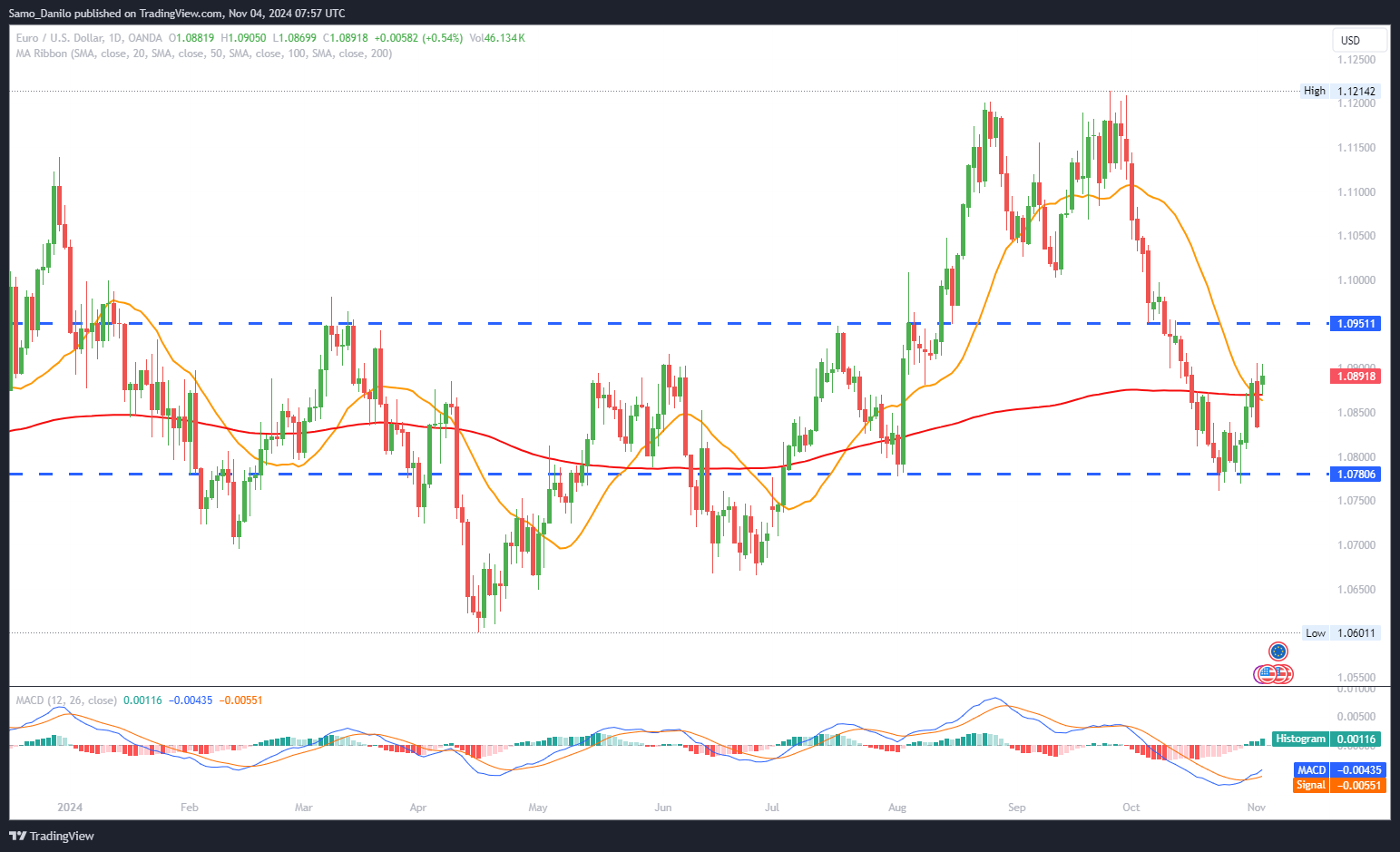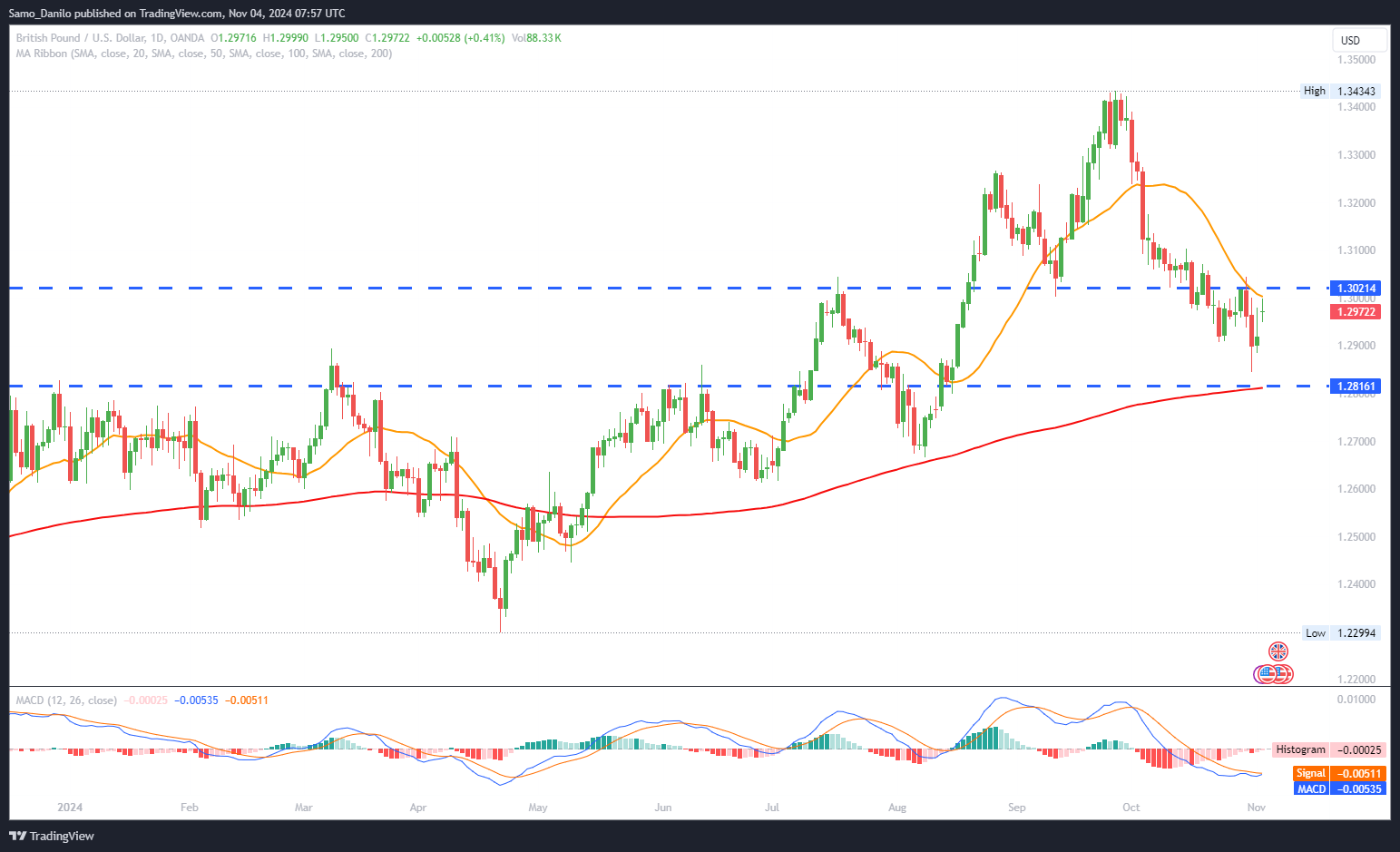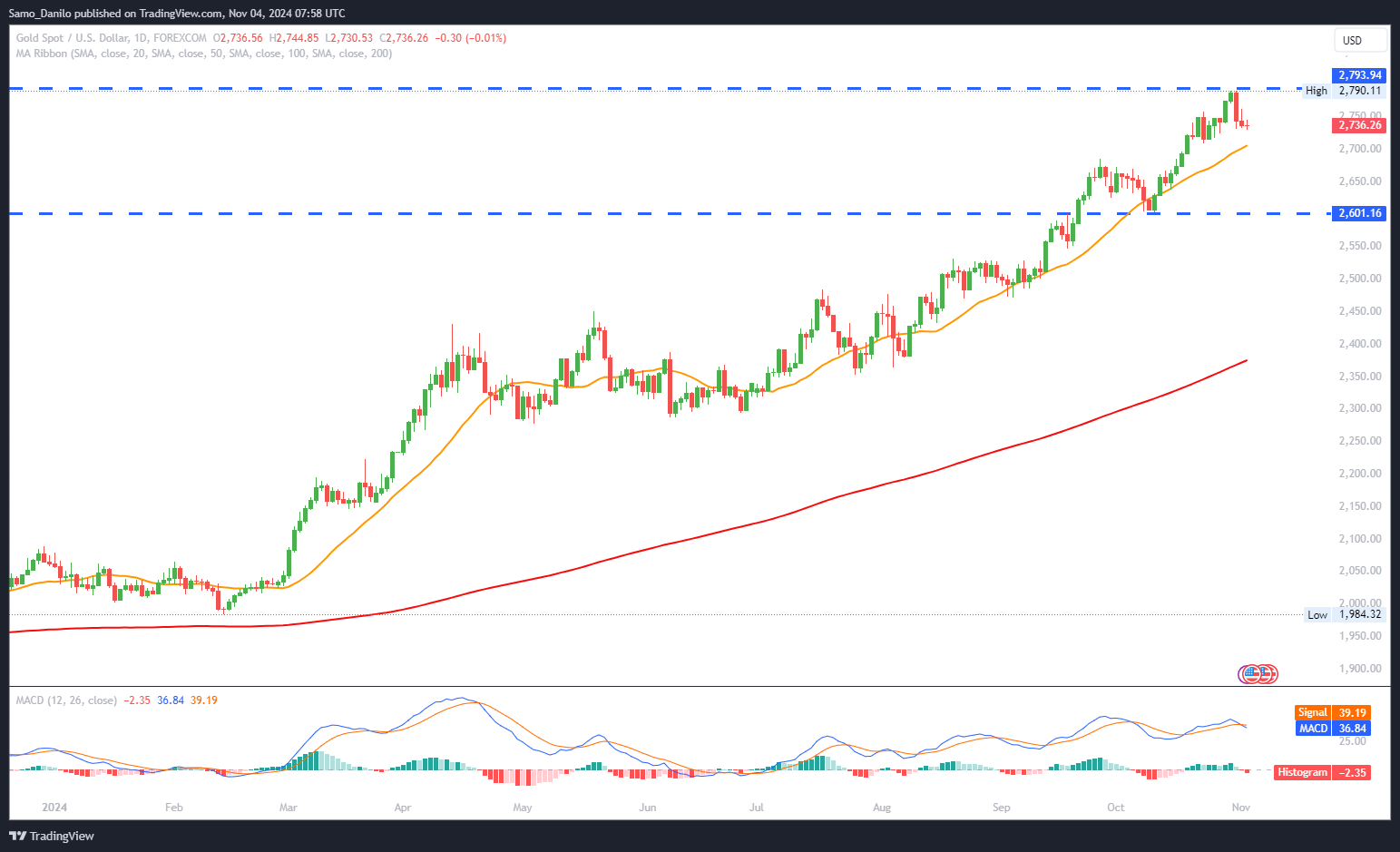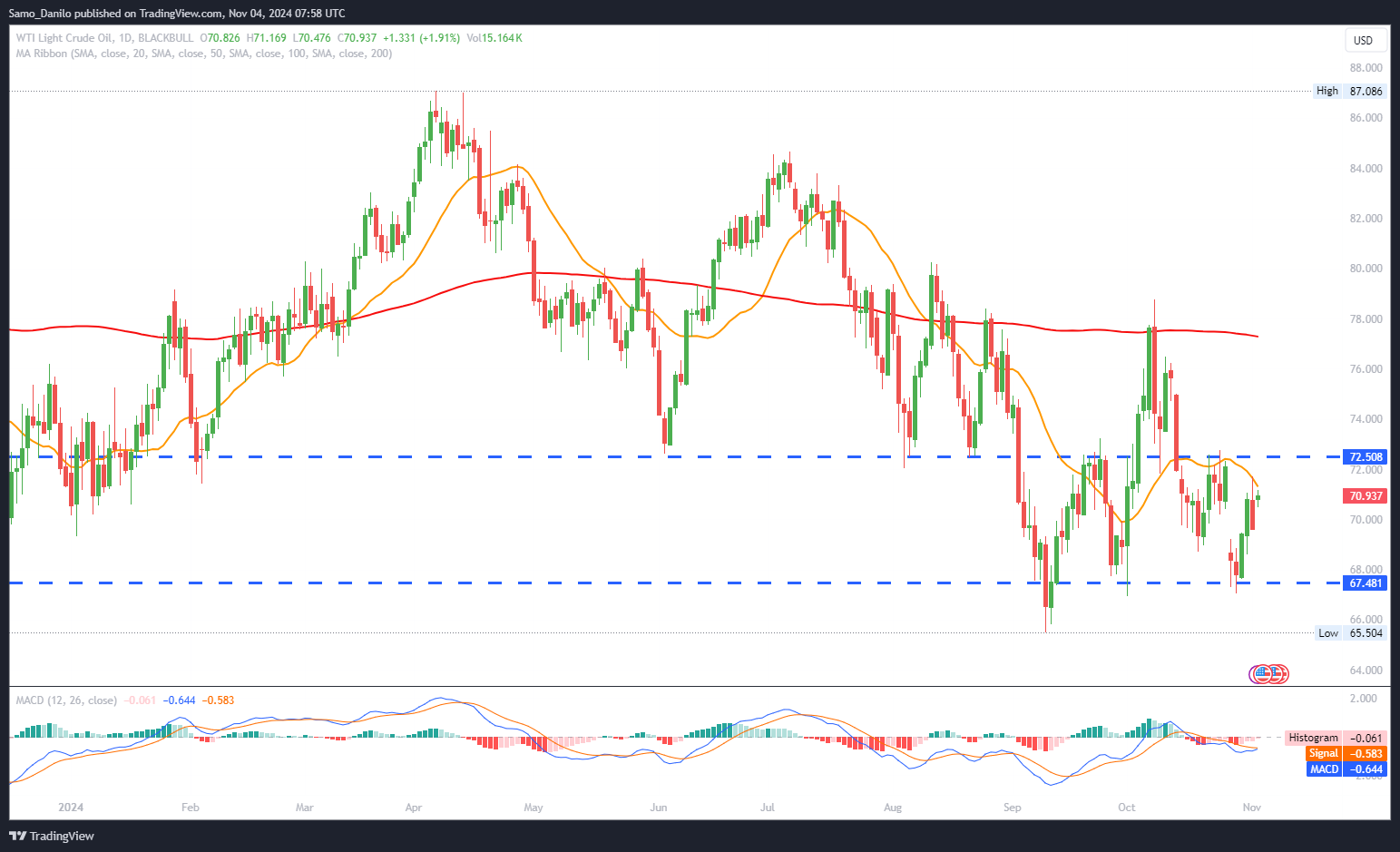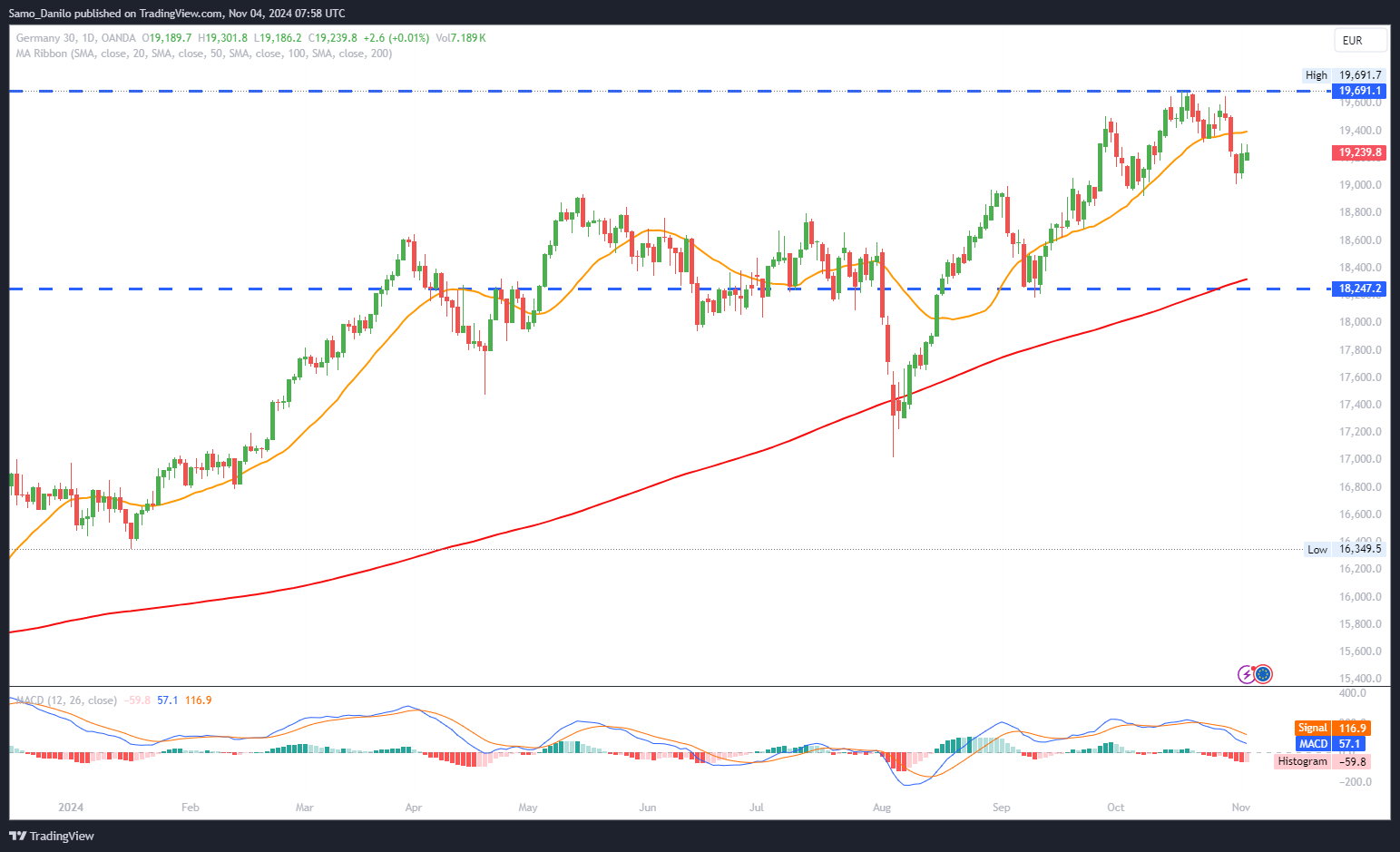EURUSD
- Current Trend: The EUR/USD pair is consolidating around 1.0900 in early European trading on Monday, maintaining stability after a recent upswing, with traders weighing mixed signals from US and Eurozone economic data.
- US Labor Market Data: Friday’s Nonfarm Payrolls (NFP) report revealed a disappointing increase of 12,000 jobs in October, well below the expected 113,000 and September’s revised 223,000 figure. This substantial miss in job creation underscores challenges in the US labor market and may influence Fed policy discussions.
- US Election: According to a New York Times/Siena College poll cited by Reuters, Kamala Harris and Donald Trump remain in a tight race across seven key battleground states, intensifying market caution with the US presidential election only days away.
- Eurozone Data: The Euro gained some support from stronger Q3 economic growth and higher-than-expected Eurozone inflation, which led traders to rethink the likelihood of a substantial ECB rate cut in December.
- Inflation Data: Preliminary data showed that the Eurozone Harmonized Index of Consumer Prices (HICP) rose to 2.0% YoY in October, surpassing expectations of 1.9%, while core inflation held steady at 2.7%. These figures reinforce the possibility that the ECB may proceed cautiously with further rate cuts.
Closing statement: The EUR/USD is stabilizing around 1.0900 as markets react to weaker-than-expected US labor data, heightened pre-election uncertainty, and persistent Eurozone inflation. Investors are closely monitoring upcoming Fed and ECB meetings, as well as political developments in the US, for direction on future policy moves.
GBPUSD
- Current Trend: GBP/USD is hovering near the 1.3000 level on Monday morning in European trading, holding onto its recent gains while testing the 20-day moving average, suggesting a cautious yet optimistic outlook.
- US Dollar Movement: The US Dollar is experiencing a slight dip as traders brace for the US presidential election. Market sentiment varies depending on election outcomes, with Trump’s policies on immigration, tax cuts, and tariffs seen as potentially inflationary, impacting treasury yields and USD value, whereas Harris is perceived as a candidate of continuity with fewer immediate economic shifts.
- US Manufacturing Data: The ISM Manufacturing PMI dropped further in October, registering 46.5 compared to 47.2 in September, indicating contraction in the sector and possibly weakening the Greenback as US growth momentum appears to be slowing.
- Upcoming Fed Policy: Attention is shifting toward the Federal Reserve's policy meeting on Thursday, with market consensus leaning toward a 25-basis-point rate cut, expected to bring interest rates down to 4.50%-4.75%. This anticipated cut may add downward pressure on the USD, potentially supporting GBP/USD.
- Bank of England Outlook: The Bank of England (BoE) is also likely to announce a rate cut at its meeting on Thursday. While Labour’s recent budget includes tax hikes, it’s anticipated to spur higher inflation in the UK next year, which the BoE may need to navigate cautiously as it balances rate adjustments.
| SMA (20) | Falling |
|
|
| RSI (14) | Slightly Falling |
| |
| MACD (12, 26, 9) | Falling |
|
|
Closing statement: The GBP/USD pair is trading around 1.3000 as it responds to political and economic developments on both sides of the Atlantic. With the upcoming Fed and BoE rate decisions, as well as the potential impact of the US election, GBP/USD traders are positioned for increased volatility, depending on policy shifts and election results.
GOLD
- Current Trend: Gold is trading in positive territory on Monday, with support around the $2,730 level. This area has emerged as a demand zone, maintaining an upward bias in the gold market.
- US Election: The tight race between Democratic candidate Kamala Harris and Republican Donald Trump adds a layer of uncertainty as Americans prepare to vote on Tuesday. Political uncertainty often increases safe-haven demand for assets like gold, which could see an uptick in demand if election results are delayed or contested.
- US Job Data Impact: Recent data from the US Bureau of Labor Statistics (BLS) on Friday reported a modest increase in Non-Farm Payrolls (NFP) by only 12,000 in October, with previous months revised downward. The Unemployment Rate remains at 4.1%, signaling slower employment growth. While this could initially support gold, the response will depend on market interpretation of Fed policy moves in reaction to the labor market's slowdown.
- Dollar Demand and Yields: Renewed demand for the US Dollar and rising yields are weighing on gold’s potential gains, as higher yields make non-yielding assets like gold less attractive. This may keep a cap on further upside until clearer direction emerges post-election and Fed meeting.
- Upcoming Fed Meeting: With the Federal Reserve’s policy meeting scheduled for Thursday, markets are anticipating a 25-basis-point rate cut. If confirmed, this move could weaken the USD, providing an uplift for gold; however, if the Fed opts for a hawkish stance, gold may face additional headwinds.
| SMA (20) | Rising |
|
|
| RSI (14) | Slightly Rising |
| |
| MACD (12, 26, 9) | Rising |
|
|
Closing statement: Gold is positioned at a pivotal support level around $2,735 as investors await the outcome of the US presidential election and Fed policy decision later this week. The election uncertainty and potential Fed rate adjustments will likely set the tone for gold prices in the near term, with safe-haven demand and USD strength acting as primary influences.
CRUDE OIL
- Current Trend: WTI crude oil is trading around $70.80 per barrel, reflecting a 2% increase in Monday’s European session. The price gain is driven primarily by supply dynamics and geopolitical events.
- OPEC+ Output Delay: The OPEC+ coalition, consisting of the Organization of the Petroleum Exporting Countries (OPEC) and allies like Russia, has decided to delay a planned production increase. This postponement of added supply supports prices, as reduced production keeps the market tighter than anticipated, bolstering WTI oil.
- US Presidential Election Impact: The upcoming US presidential election on Tuesday, with Kamala Harris and Donald Trump in a close contest across battleground states, has added to market uncertainty. The election outcome may significantly influence future US economic policies, which, in turn, could impact oil prices due to expected shifts in energy regulations and foreign trade policies.
- FED Decision: Markets are eyeing the Federal Reserve's decision on Thursday, with a 25-basis-point rate cut anticipated. Should the Fed enact the cut, this could lead to a weaker USD, potentially making oil (priced in dollars) more attractive for buyers using other currencies and therefore supporting oil demand.
- China’s Economic Stimulus: China’s Standing Committee of the National People's Congress is in session from November 4 to 8. The committee is expected to approve additional stimulus measures aimed at addressing economic slowdown. If implemented, these measures could lift demand in the world’s second-largest oil- consuming nation, providing further support for oil prices.
| SMA (20) | Slightly Rising |
| |
| RSI (14) | Slightly Rising |
| |
| MACD (12, 26, 9) | Falling |
|
|
Closing statement: Crude oil prices are maintaining an upward trend, supported by OPEC+ production decisions, election-related market uncertainty, and anticipated economic stimulus from China. This week’s US election and Fed meeting will be critical to the short-term price outlook, with geopolitical events and monetary policy decisions likely dictating near-term demand and price direction.
DAX
- Recent Gains: The DAX index rose by 0.93% on Friday, reversing the prior day’s losses of 0.93%, primarily driven by increasing speculation on a December rate cut by the Federal Reserve. This shift in interest rate expectations fueled investor demand for riskier assets, including stocks listed on the DAX.
- Chinese Economic Indicators: China’s Caixin Manufacturing PMI exceeded expectations, moving from 49.3 in September to 50.3 in October, signaling a return to expansion. This improvement has uplifted sentiment regarding China’s economy, which could positively impact global demand and, indirectly, DAX-listed companies with exposure to China’s markets.
- German Data: Attention is now focused on Germany’s finalized HCOB Manufacturing PMI, due Monday, which is projected to confirm an increase from 40.6 in September to 42.6 in October. Any deviations from these estimates could influence expectations around Germany’s industrial sector health and demand for DAX components.
- US Employment and Fed Outlook: Friday’s US Jobs Report further supported investor bets on a December Fed rate cut. The data showed nonfarm payrolls grew by just 12,000 in October, down from 223,000 in September, with unemployment steady at 4.1%. A weaker labor market could increase the likelihood of a Fed rate cut, potentially weakening the USD and benefiting export-driven stocks on the DAX.
- Factory Orders Data: Investors will also watch the US factory orders report on Monday, where a 0.4% decline is expected for September, following a 0.2% decrease in August. Lower-than-expected orders could reinforce the possibility of easing measures by the Fed, indirectly supporting the DAX by reducing global risk aversion.
| SMA (20) | Rising |
|
|
| RSI (14) | Slightly Falling |
| |
| MACD (12, 26, 9) | Slightly Rising |
|
Closing statement: DAX stocks are being buoyed by both local and international developments, including stronger-than-expected Chinese economic data and potential Fed rate cuts. German and US data this week will be critical for investors, who remain focused on economic indicators that may either support or temper expectations for global demand stability.
